With World 2-2, Super Mario Bros. officially breaks from the standard cycle of previous Mario games. Rather than cycling back through the previous four levels after conquering them, the hero moves on to new and bigger challenges. The classic arcade level-cycle approach still holds some vestigial sway here, as the subsequent seven worlds do generally repeat the format of World 1 — begin with basic ground-based action, venture underground, emerge into a platform-based challenge of agility, and face off against the boss in a castle — but no two levels are exactly alike from here on out. Instead, they grow progressively more difficult not through changing enemy behavior or speed but rather though cannier level layouts.
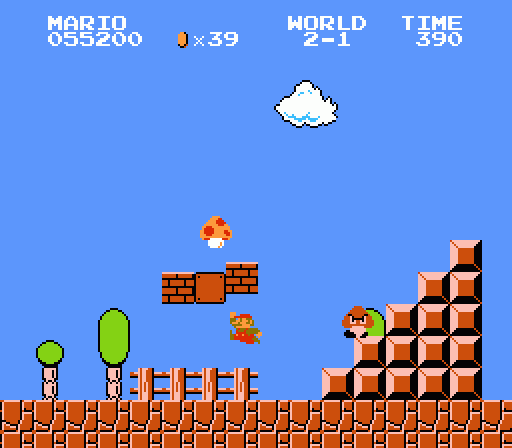
In some ways, the game really starts here. Which is sort of ironic, since few people play through World 2 once they find the Warp Pipes in World 1-2. They either skip all the way ahead to World 4-1, or else they jump to World 3-1 so they can farm 1UPs.
The previous levels had little moments of challenge, but generally speaking they were pretty simple, designed to ease new players into both the game and the genre. World 2-2 is much more varied and much more challenging than anything that has come before. Take it slowly and you’re fine — but at every turn, you’ll come across little moments designed to make you give in to haste and screw up.
On the plus side, it begins with a kindly touch, offering you a Mushroom first thing. The first enemy you encounter comes immediately after the mushroom: A Goomba descending a staircase. Simple, easy, but a little different and unexpected.
Over the staircase is an interesting trap that lets you play around with the mechanics of turtle shells. Your first instinct here is probably to hop on the first turtle and kick it into the second, but doing so will send the kicked shell into an endless ricochet as it bounces between the walls. The longer you stay in this pit, the more likely you are to be hit by the shell. But, you know, you can also jump onto the shell to halt its motion. So, while this can be a dangerous situation, it’s deadly only because of circumstances you create… and which you can defuse.
Your turtle evasion is also very likely to cause you to bump into the hidden block in this pit, located in the space immediately left of the bricks overhead. The coin block you reveal can be an impediment if by bumping your head you smack into a turtle or shell, but it also provides a spot of safety removed from the shell bounce. And if you try to use it as a stepping to stone from which to vault over the bricks above, you’ll uncover another hidden block which contains a precious 1UP. So despite the danger inherent in this little space, there’s tremendous value in it as well.
Speaking of 1UPs, this stage teases you a couple of times with areas where you can kick a turtle shell into enemies and chase after it and almost rack up enough points for an extra life… but not quite. Eventually, the shell will hit another wall and rebound at you, which can be dangerous if you’re running full pelt and don’t have time to react. By and large, I would say the essential theme of World 2-1 is “turtle shells bounce off walls and kill you.” It’s a handy lesson to learn.
The big new feature in World 2-1 is somewhat of a hidden feature: A secret vine contained in a slightly inconvenient and slightly innocuous block. Striking the block will cause a vine to rise up and off the screen. Surprise: Mario can climb. If you hop on the vine, he’ll scoot up and into the sky, where awaits a bonus area.
Fundamentally, this area isn’t any different than the underground coin depots hidden down pipes in Worlds 1-1 and 1-2, but it feels functionally distinct. It’s mostly just window dressing — you’re running along happy clouds in the sky rather than scurrying through a dank hole in the ground — but there is a mechanical difference as well. The coins are too high up to be reached easily with a normal jump, so you’re meant to ride the small platform that slides along parallel to the ground to help boost you high enough to snag the prizes. A pair of three-coin clusters (one midway through, one at the end) challenge you to break from the rote motion of gathering the other coins in order to snag them all. This area is completely hazard-free, a pure bonus, to the point that when you fall into the “pit” at the end you will land safely back in the main level.
Pipes comprise another major feature of this stage, and most of them have Piranha Plants in them. If you don’t feel like taking the coin route, you can snag a Starman that’ll let you plow your way through to the end of the stage, mowing down every critter that stands in your way. Unlike in later Mario games, the points you earn for consecutive kills with a Starman don’t multiply, so grabbing the power-up is less valuable here than taking the time to pick up as many coins as possible. Them extra lives….
And finally, one last new feature to contend with: The spring. I’m almost certain this is a call back to the third stage of Donkey Kong, where the ape chucked these things at you, but here they work in your favor. Hop on the spring and Mario will bounce off, but it’s not a high enough bounce to send him over the wall here. Instead, you have to time a second button press so that you jump right as the spring reaches its maximum compression — that’ll boost Mario’s natural jump to send him sailing over the wall. This is a pretty gentle way to teach the slightly tricky timing involved here, as this is a safe area at the end of the stage, and you’re free to continue fussing with the action until you finally master it. Or until time runs out, I suppose.
The high, narrow wall here serves the function normally reserved for the end-of-level staircase. We saw the layout of the closing staircase undergo its first mutation in World 1-3, but here it’s an even more dramatic change. There’s not enough room to build up momentum to leap to the top of the flagpole at the end of the level at the top of the column. Instead, you need to carry over running momentum across a perfectly timed spring jump.
So, this spring scenario works on two levels. One, it teaches you the basic mechanics of the spring. Two, it teaches you the inertia that extends across even special jumps like this. You can simply finish the level, or you can nail the physics and finish it with style.
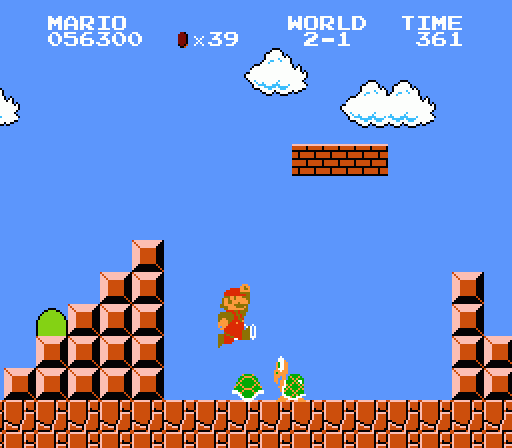
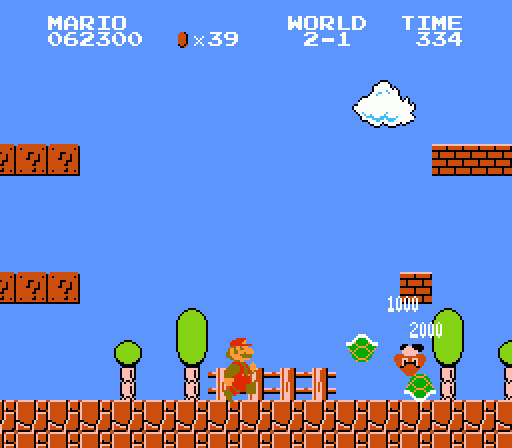
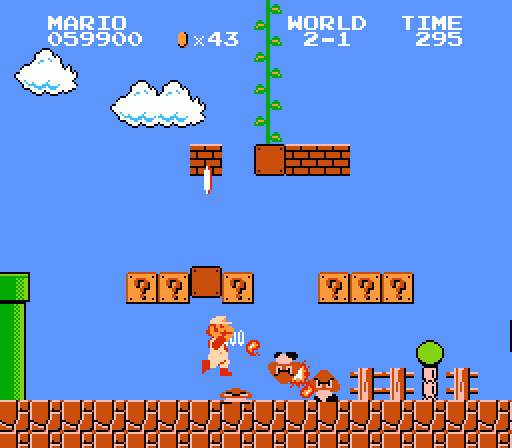
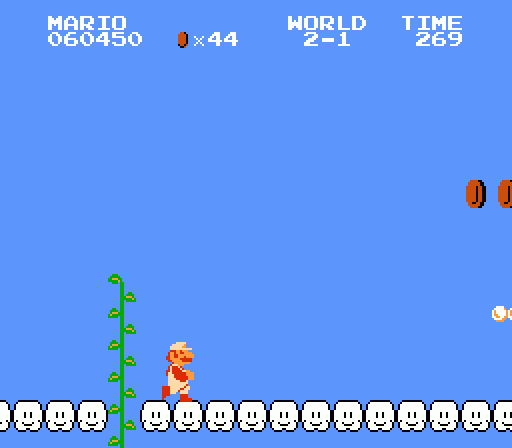
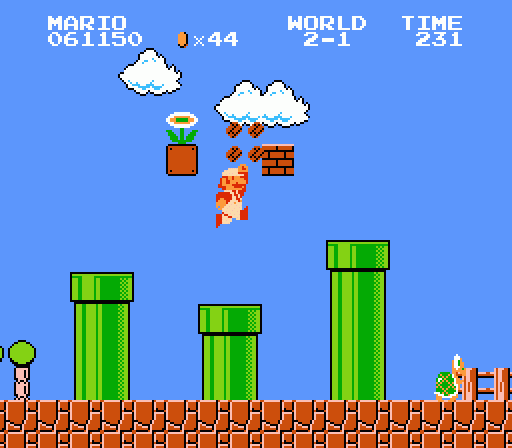
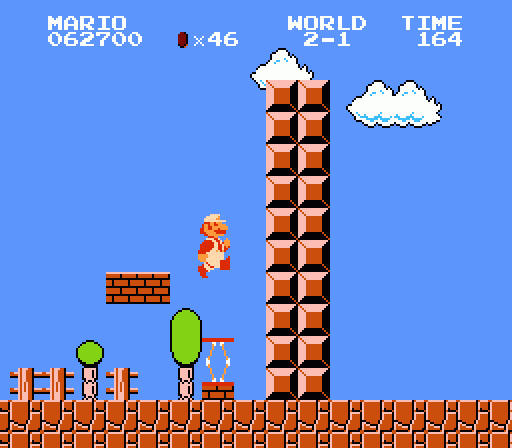
I would think the springboard would be just as much of a call back to its previous repurposing as a jumping device in Donkey Kong Jr., which I believe used the same sprite as DK’s Springboards of Doom.
According to Super Smash Bros. Brawl, the things Donkey Kong throws at you in stage 3 are actually jacks, not springs!
Any comments on the factors regarding the hidden 1UP in 2-1? Like I mentioned in the 1-3 post it doesn’t always spawn, and seems to be tied to collecting all of 1-3’s coins. I’ve found similar hidden 1UPs in the other #-1 worlds, at least up to 6-1.
As for the whole shell thing, I’ve seen lots of areas in Super Mario Bros. where it looks like you can pull off a 1UP chain kill but can’t. Unless you can reliably pull off that 1UP trick, Super Mario Bros. is actually pretty stingy with extra lives, especially compared to later games that practically BURY you in them.
If I recall correctly, it took until Super Mario World before you could kill chains of enemies with a star to get 1UPs.
I thought the hidden 1up’s are entirely dependent on whether or not you warp to said level. If you warp they will be available. If you play straight through, they will not be available.
If thats the case, and I think it is, then that is one of the few design choices in SMB that I really dislike.
That’s certainly not the case with the 1UP in 2-1, since I didn’t warp.
I didn’t realize the 1UPs were conditional, honestly. I’d be curious to see documentation on them.
There is definitely some mysticism regarding the appearance of 1ups in SMB. I’m pretty sure the one in 4-1 only appears if you warp. Or maybe what ever conditions allow it to show happen to be in place when I warp.
Parish:
http://www.youtube.com/watch?v=Crk27A-FJEo
Don’t feel bad about not knowing this, the secret 1ups information is somewhat recent news on fan forums (at least, I don’t remember people talking about it more than a year ago). However, it should only take one journalist to bring it to the mainstream. *hint hint*.
Hmm, the spring… first ever double jump?
Thanks for the video Rey. It seems like a game from 1985 would have all its secrets discovered by now, but that information was new to me.
I’m continually amazed by how well SMB has stood the test of time.
I don’t know how that 1up secret hasn’t exploded on all news sites/blogs considering the cloudbush thing was talked about as if it was the second coming